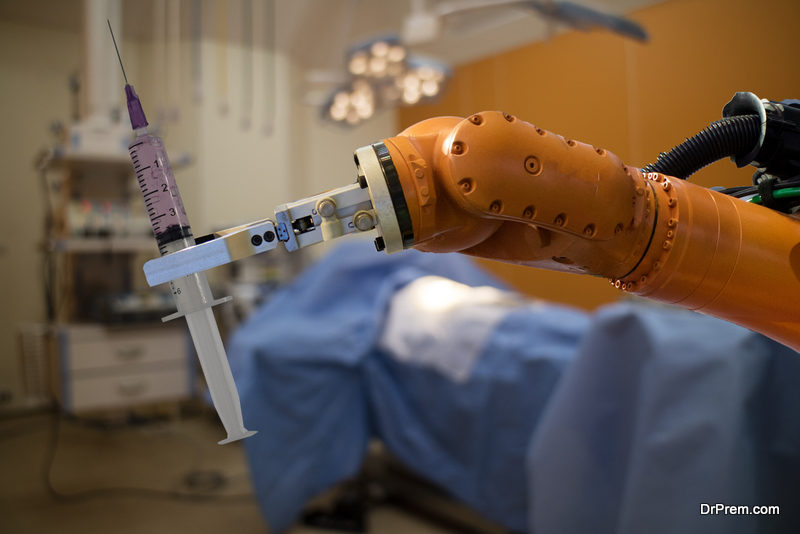To say technology has transformed the world lately is an understatement. From education and architecture to communication and travel, technology is responsible for countless advancements and improvements in how things are done. And the healthcare industry is no different. While some of the tried-and-true methods of doing things are still used, we’ve discovered better, faster, and more accurate ways of offering the best medical care and treatment to patients. Here are just a few ways that technology is changing the landscape of the healthcare.
1. Artificial Intelligence (AI)
 No talk of technology would be complete without touching on AI (artificial intelligence). While this may seem like something out of a Sci-Fi movie, AI is revolutionizing countless industries — including healthcare. When it comes to speed, nothing can outthink or outsmart technology. Even the smartest minds in the medical field are no match for AI. And with countless illnesses that require fast action from terminal cancer to neurological and degenerative disorders, getting answers fast can be a matter of life or death. But speed isn’t the only benefit to using AI. It may actually prove to be cost effective — for both establishments and patients. It’s predicted that by the year 2026, AI might save the healthcare industry a whopping $150 billion!
No talk of technology would be complete without touching on AI (artificial intelligence). While this may seem like something out of a Sci-Fi movie, AI is revolutionizing countless industries — including healthcare. When it comes to speed, nothing can outthink or outsmart technology. Even the smartest minds in the medical field are no match for AI. And with countless illnesses that require fast action from terminal cancer to neurological and degenerative disorders, getting answers fast can be a matter of life or death. But speed isn’t the only benefit to using AI. It may actually prove to be cost effective — for both establishments and patients. It’s predicted that by the year 2026, AI might save the healthcare industry a whopping $150 billion!
2. Virtual Reality (VR)
What’s AI without VR? Virtual reality entered the scene around the same time as artificial intelligence — taking the technology world by storm. What better way for up and coming medical professionals to learn than through hands-on experience? But what about when real hands-on experience isn’t possible? Enter, virtual reality. Students in different countries, time zones, and institutions may have the opportunity to experience what it’s like to perform surgery and treat patients through the wonder that is VR. And what about putting medical students in the place of their patients?
VR allows doctors to experience what it feels like to have osteoporosis, cancer, or visual and auditory impairments. This can help them not only sympathize with patients but also discover and brainstorm advanced ways of treating these common ailments. An added bonus? A better understanding of the patients’ needs and empathy for their circumstance.
3. Augmented Reality
 We might as well get all of the basic technological advancements out of the way from the beginning! Augmented reality, while similar to VR and AI, is slightly different. But no less beneficial to the medical field. The major difference between virtual reality and augmented reality is that through VR, users are virtually transported to another time and place, losing touch with reality. This doesn’t happen with augmented reality.
We might as well get all of the basic technological advancements out of the way from the beginning! Augmented reality, while similar to VR and AI, is slightly different. But no less beneficial to the medical field. The major difference between virtual reality and augmented reality is that through VR, users are virtually transported to another time and place, losing touch with reality. This doesn’t happen with augmented reality.
Some of the most common forms of AR (augmented reality) are digital images and sounds projected for real-time application. AR also speeds up the process of new technology reaching patients. Through the use of apps and online training, creators can train medical staff quickly and efficiently, getting the necessary information into the hands of professionals faster. This is where remote training comes into play — creating widespread use of beneficial tools and knowledge.
4. Wearable Technology
There’s no better way to put control of their own health in the hands of patients than through wearable technology. From Apple watches to Fitbits, it’s never been easier to track your activity, diet, and weight loss goals. More than 35% of adults in America are obese. Obesity leads to a long list of health complications including diabetes, high blood pressure, and heart disease. Wearable technology helps patients track their own progress. This not only holds them accountable, but also helps put them in the driver’s seat in terms of improving their health and current condition. Doctors and patients can discuss their progress, set goals, and make adjustments as needed.
Aside from fitness trackers, there’s also been a rise in the use of RPM – remote patient monitoring. This is most popular among senior citizens choosing to age in place. RPMs track everything from their vitals to their activity, relaying all of the information directly to their doctors. This reduces the number of doctor visits and helps doctors monitor and treat patients remotely. Patients can stay in the safety and comfort of their own home, and doctors will experience less wait times in the office.
5. Advanced Software
 We’ve all been there. You show up at the doctor’s office in time for your appointment, only to be met with a stack of forms and paperwork to fill out. Most doctor’s offices now offer patient registration forms online and encourage you to fill them out prior to arriving in the office. This saves you and the doctor’s office ample time. What’s even better, is that those digital records are then accessible on the computer for doctor’s offices and specialists to share. No more faxing necessary information from one doctor to another. This makes collaboration and communication seamless among professionals and with doctors and patients. This useful software is just one example of how it’s done.
We’ve all been there. You show up at the doctor’s office in time for your appointment, only to be met with a stack of forms and paperwork to fill out. Most doctor’s offices now offer patient registration forms online and encourage you to fill them out prior to arriving in the office. This saves you and the doctor’s office ample time. What’s even better, is that those digital records are then accessible on the computer for doctor’s offices and specialists to share. No more faxing necessary information from one doctor to another. This makes collaboration and communication seamless among professionals and with doctors and patients. This useful software is just one example of how it’s done.
6. Robotics
If you or someone you know has recently had surgery or a procedure done, you already know that things aren’t the way they used to be — in the best way possible. The days of making giant incisions that leave lasting scars are gone. Microscopic surgery allows doctors to enter a patient’s body using cameras of almost pinhole size. This surgery is used primarily for blood vessels and nerves. But even major surgery including gallbladder removal and some cosmetic procedures are done using robotic technology that leaves minimal evidence of an entry point. Robotics are also used for surgery, companionship, and rehabilitation.
Some aspects of healthcare should never change. Things like bedside manner and confidentiality will always be required in the healthcare field. But holding onto dated ways of doing things only hurts patients and efficiency. These advancements in technology are transforming the healthcare industry for the better. And chances are, these are just the beginning.
Article Submitted By Community Writer




